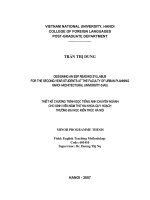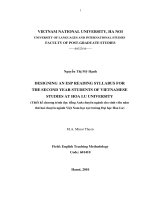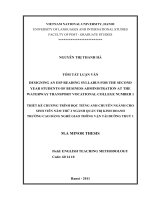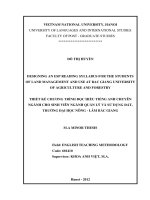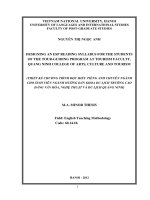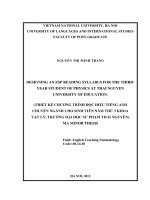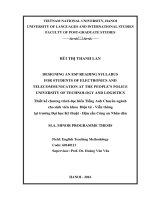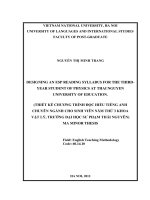Designing an esp reading syllabus for the second year students at the faculty of urban planning hanoi architectural university (HAU)
Bạn đang xem bản rút gọn của tài liệu. Xem và tải ngay bản đầy đủ của tài liệu tại đây (413.17 KB, 65 trang )
i
TRN TH DUNG
!"#$%&'$()!$%$!*+$$%,$
!"#$%&'$()!$%$!*+$$%,$ !"#$%&'$()!$%$!*+$$%,$
!"#$%&'$()!$%$!*+$$%,$
!-.$/+$$012 -3*-4!
!-.$/+$$012 -3*-4!!-.$/+$$012 -3*-4!
!-.$/+$$012 -3*-4!
&"5$%(4)! $&6!,$7
&"5$%(4)! $&6!,$7&"5$%(4)! $&6!,$7
&"5$%(4)! $&6!,$7
ield: English Teaching Methodology
Code: 601410
Supervisor: Dr. Dng Th N
i
On the completion of this thesis, I would like to express my deepest gratitude to my
supervisor, Dr. Duong Thi Nu, who gave me precious guidance, comments, suggestions
and encouragement throughout my research.
My special thanks go to all my teachers of the Post-graduate course 13 at Vietnam
National University, College of Foreign Languages, Hanoi, for their interesting and useful
lectures.
I also wish to convey my sincere thanks to all my colleagues and the second-year
students at the Faculty of Urban Planning, Hanoi Architectural University, for their
contribution to the data collection and their constructive suggestions for this research.
Finally, I am grateful to my friends and my family who gave me support and
encouragement during the time of fulfilling this work.
ii
I certify my authority of the Study Project Report submitted entitled
In total fulfillment of the requirements for the degree Master of Arts
Trn Th Dung
September 2007
iii
This study aims at designing an ESP reading syllabus for the second-year students
at the Faculty of Urban Planning, Hanoi Architectural University (HAU) to meet the
demand for an appropriate ESP course of the students at this faculty.
The study consists of three main parts: Introduction, Development and Conclusion.
The Introduction states the rationale, aims and objectives, scope, methods and
design of the study.
In the main part of the study, the Development, there are three chapters. Chapter 1
presents the review of relevant theories for designing an ESP reading syllabus, namely
definition of syllabus, the role of the syllabus, types of ESP syllabus, approaches to
syllabus design, steps in syllabus design, needs analysis and reading theories. In chapter 2,
basing on an overview of the teaching and learning situation at HAU and the background
of the target students, the need analysis was conducted with instruments of questionnaires
and interviews to gather information on students’ target needs and learning needs. The data
were collected from various sources: the second-year students, the ex-students, the ESP
teachers and the subject teachers. The results of the needs analysis provide the basis for the
researcher in choosing the appropriate syllabus type, determining the objectives, selecting
and sequencing the content of the syllabus. The proposed syllabus for the target students is
presented in the last chapter of this part - chapter 3.
The Conclusion summarizes the thesis, points out its limitations and proposes
suggestions for further study.
The proposed syllabus is expected to meet the students’ needs as well as the
training objectives of HAU and will make contribution to the improvement of ESP
learning and teaching at this university.
iv
Pages
Acknowledgement i
Declaration ii
Abstract iii
Table of contents iv
List of abbreviations vi
1. Rationale 1
2. Aims and objectives of the study 2
3. Scope of the study 2
4. Methods of the study 2
5. Design of the study 2
! "
!#$ "
1.1. Syllabus design 4
1.1.1 Definition of syllabus 4
1.1.2. The role of the syllabus 5
1.1.3. Types of ESP syllabus 6
1.1.3. 1. Grammatical or structural syllabus 6
1.1.3.2. Notional/functional syllabus 6
1.1.3.3. Situational syllabus 7
1.1.3.4. Topic-based syllabus 7
1.1.3.5. Skill-based syllabus 7
1.1.3.6. Task-based syllabus 7
1.1.4. Approaches to syllabus design 8
1.1.4.1. The language-centered approach 8
1.1.4.2. The skills-centered approach 8
1.1.4.3. The learning-centered approach 9
1.2. Needs Analysis in ESP 10
1.2.1. Needs Analysis 10
1.2.2. Types of Needs 11
1.2.2.1. Target Needs 11
1.2.2.2.Learning Needs 11
1.3. Reading 12
1.3.1. Reading in ESP 12
1.3.2. Reading skills/ strategies 13
1.4. Summary 14
v
!%&#'
2.1. Introduction 15
2.2. The teaching and learning situation at HAU 15
2.3. The target students 17
2.4. The teaching staff of the English section 17
2.5. A critical look at the existing syllabus 18
2.6. The study 19
2.6.1. The subjects 19
2.6.2.Instruments for collecting data 19
2.6.3.The findings 20
2.6.3.1. The findings of the questionnaires 20
2.6.3.1.1. Needs perceived by the teachers of the English section 20
2.6.3.1.2. Needs perceived by the subject teachers 24
2.6.3.1.3. Needs perceived by the target students 24
2.6.3.2.Results from the interviews with the graduates 25
2.7. Summary 26
!(!!!&
)& & *+ ,*
%-
3.1. Aims and objectives 27
3.2. Selecting a type of syllabus for ESP students at the Urban Planning Faculty, HAU 28
3.3. Sequencing 29
3.3.1. Selecting the content 29
3.3.1.1. Specific topics in the syllabus 29
3.3.1.2. Reading skills and reading exercises 29
3.3.1.3. Grammar and structures 30
3.3.2. Grading the items in the syllabus 31
3.3.3. The organization of the syllabus 32
3.3.3.1. Time allocation 32
3.3.3.2. Quantity and structure of the syllabus 32
3.4. Designing tests for the ESP reading course 32
3.5. The proposed syllabus for the second-year students at the Faculty of Urban
Planning, HAU 33
3.6. Summary 33
(.
/"#
!!
vi
$
HAU: Hanoi Architectural University
ESP: English for Specific Purposes
UPF: Urban Planning Faculty
1
1. Rationale
There is no doubt of the importance role that English plays in our society, especially in
the process of regional and global integration. People with a good command of English are
needed in many fields. This results in the great demand of learning English, manifested by
the boom of English centers across the country. At universities, students now realize the
importance of English to their future work and they have paid more attention to the study
of English, especially English for Specific Purposes as this young branch of English is
rarely taught outside their universities.
For these students, reading is by far the most important skill as they hardly have
opportunity to use communicative English outside the classroom. However, they need to
get access to a great number of specialized documents written in English so as to broaden
their knowledge about their speciality as well as to obtain up-to- date information in their
fields of study. Reading is also very necessary in their future work. Therefore, designing a
syllabus focusing on improving students’ ESP vocabulary and their reading skills in ESP is
of great importance in order to prepare the students for their future job.
At Hanoi Architectural University (HAU), English is a compulsory subject for students
of all faculties. It is taught within 2 stages. In the first stage, students learn General English
(150 periods) according to Headway Pre-intermediate course book written by John & Liz
Soars (1987). After 2 semesters learning General English, they progress on to the ESP
(English for Specific Purposes) stage in which they learn 60 periods in their second year at
HAU. At this stage, students as well as teachers of English have faced a lot of difficulties
due to the lack of an appropriate ESP teaching syllabus. There are 5 faculties at HAU; each
has its own specialist characteristics. However, students of these different facilities have to
study the same course book “English for Architecture, Civil Engineering, Urban Planning
and Urban Infrastructure Techniques” (2002), written by a group of teachers of English at
HAU. Unlike what its name suggests, this course book only focuses on Architecture and
Civil Engineering, and it is certain that it cannot satisfactorily meet the needs for an ESP
course of students coming from 5 different faculties. Therefore, designing an appropriate
ESP syllabus for the students of each faculty is necessary.
The faculty of Urban Planning is one of the main faculties at HAU, so it is one of the
2
faculty in which the job of designing an ESP reading syllabus should be carried out first.
For the above-mentioned reasons, I decided to choose the topic “Designing an ESP
reading syllabus for the second-year students at the Urban Planning Faculty, HAU” as the
topic of my thesis.
2. Aims and objectives of the study
This study aims at designing an ESP reading syllabus for the second-year students at the
Urban Planning Faculty, HAU. In order to achieve this aim, the following objectives are
set to follow:
- To get an overview of the theories related to ESP reading and syllabus design
- To identify the needs perceived by the ESP students, the ESP teachers and the
subject teachers toward an appropriate reading syllabus for the ESP students of the
Urban Planning Faculty
- To propose a reading syllabus based on needs analysis
3. Scope of the study
This study is initiated and developed from the urgent need to design an effective
ESP syllabus for the second-year students at the Urban Planning Faculty, HAU. It is
conducted within HAU and focuses on Urban Planning, one of the major professions at the
university. Due to the general institutional academic situation, priority is given to reading
skill. Within the scope of a minor thesis, this study focuses on the designing process itself;
only the basic theories related to ESP reading and syllabus design are presented.
4. Methods of the study
In this study, both quantitative and qualitative methods are used. The quantitative
method is used to collect data by means of questionnaires. There are three kinds of
questionnaires, one aims at the second-year student population learning ESP, another aims
at the ESP teachers of the English section and the last aims at the subject teachers at the
Urban Planning Faculty, HAU so as to identify the needs for an ESP syllabus from a broad
view. The qualitative method is used to collect data through interviews with ex-students of
the Urban Planning Faculty as well as through informal discussions with colleagues.
5. Design of the study
This study contains three main parts.
Part A- Introduction presents the rationale, aims and objectives, scope, methods and
the design of the study
3
Part B- Development, which is the main part of the study, consists of three chapters.
- Chapter I reviews the literature concerning syllabus design, needs analysis and
reading theories
- Chapter II describes in details the study including its background, subjects,
instruments for collecting data as well as the findings of the study
- Chapter III proposes a reading syllabus for the second-year students at the Faculty
of Urban Planning basing on the findings of the study
Part C- Conclusion includes a summary of the study, limitations and suggestions for
further research.
4
!
!#$
1.1. Syllabus design
1.1.1 Definition of syllabus
In language teaching, syllabus is a common notion and many teachers consider it as
a document which says what will (or at least what should) be learnt. But in fact, there have
been several different ways in which a syllabus can be defined. Some authors who
advocate the narrow view believe that syllabus and methodology should be kept separate
whereas some others who adopt a broader view argue that it is difficult to make a
distinction between content and tasks.
As a supporter of the narrow view, Nunan (1988: 5) draws a clear distinction
between syllabus design and methodology:
“Syllabus design is seen as being concerned essentially with the selection and grading of
content, while methodology is concerned with the selection of learning tasks and
activities”.
Allen (1984: 49) shared this view with Nunan in claming that “Syllabus… is
concerned with a specification of what units will be taught (as distinct from how they will
be taught, which is a matter for methodology)”.
Different from these scholars, one of the broad view advocators, Yalden (1984: 14)
stated that:
The syllabus replaces the concept of “method”, and the syllabus is now seen as an
instrument by which the teacher, with the help of the syllabus designer, can achieve a
degree of ‘fit’ between the needs and the aims of the learners (as social being and as
individual), and the activities which will take place in the classroom.
Another definition belonging to the broad view was given by Dubin and Olshtain (1986:
28): “Whatever it is called, it is a document, which ideally describes:
• What the learners are expected to know at the end of the course, or the course
objectives in operational terms
• What is to be taught or learned during the course, in the form of an inventory of
items
5
• When it is to be taught, and at what rate of progress, relating the inventory of items
to the different levels and stages as well as the time constraints of the course
• How it is to be taught, suggesting procedures, techniques, and materials
• How it is to be evaluated, suggesting testing and evaluating mechanism”
This might be the most detailed definition of a syllabus and also acts as a guideline for the
researcher during the process of syllabus design in this study.
1.1.2. The role of the syllabus
It is obvious that a syllabus is an important component in the process of course
design. Therefore, it is useful to consider the role it plays in the teaching and learning
process so as to use it most effectively. Hutchinson and Water (1987: 83-84) stated the
following roles of a syllabus:
The syllabus, in defining the constituent parts of language knowledge, provides a
practical basis for the division of assessment, textbooks and learning time. This is a very
important role of the syllabus as language is a complex entity and cannot be learnt in one
go. Therefore, in order to teach and to learn effectively, we have to break it down into
manageable units.
In addition to its practical benefits, a syllabus also gives moral support to both the
teacher and the learner in that it makes the language learning task appear manageable.
If we consider learning as a journey, then, the syllabus can be seen as a statement of
projected routes, so that teacher and learner not only have an idea of where they are going,
but how they might get there.
A syllabus is an implicit statement of views on the nature of language and learning.
It will normally be expressed in terms of what is taken to be the most important aspect of
language learning, thus, it tells the teacher and the student not only what is to be learnt,
but, implicitly, why it is to be learnt.
A syllabus also provides a visible basis for testing, an important part in language
learning and teaching.
Apart from its advantages, a syllabus also hides some dangers:
• A syllabus can never be more than a statement of a teaching ideal. It can only
constitute an approximate statement of what will be taught, but can predict very
little about what will be learnt.
6
• Syllabuses cannot express the intangible factors that are essential to learning such
as emotions, personalities, subjective views, motivation.
• Syllabuses cannot take account of individual differences. Just as they are a
statement of the ideal in language terms, they also implicitly define the ideal
learner.
It can be seen from the above list that the role of the syllabus is very complex.
Therefore, it is important to be aware of the different roles that the syllabus plays, so that it
can be used most appropriately.
1.1.3. Types of ESP syllabus
1.1.3. 1. Grammatical or structural syllabus
It is based on a theory of language that assumes that the grammatical or structural
aspects of language form are the most basic or useful. The syllabus input is a selection of
grammatical structures and structures (e.g. tenses, grammatical rules, sentence patterns)
which occur in a language and the sequence of those items for convenience in teaching.
The main advantage of this syllabus is that it is based on the principle of working from the
familiar to the unfamiliar and using the familiar to teach the unfamiliar, as stated by
McDough (1981: 21): “the transition from lesson to lesson is intended to enable material
in one lesson to prepare the ground for the next; and conversely to grow out of the
previous one”. On the other hand, one weak point of this type of syllabus is that it only
focuses on one aspect of language, that is, formal grammar and “it is difficult to isolate
and present discrete items outside a context and the links of grammatical structures can be
rather tenuous” (Nunan: 1988: 30)
1.1.3.2. Notional/functional syllabus
A functional-notional syllabus is based on learning to recognize and express the
communicative functions of language (informing, agreeing, apologizing, requesting, etc.)
and the notions that language is used to express (size, age, colour, comparison, time, and so
on). Unlike the grammatical one, this type of syllabus produces a communicative
competence without losing sight of grammatical factors. However, it is confined to short
utterances or exchanges involving the functions in questions and the complexity of grading
content input is another problem.
7
1.1.3.3. Situational syllabus
In this type of syllabus, the content of language teaching is a collection of real or
imaginary situations in which language occurs or is used. Examples of situations include:
seeing the dentist, complaining to the landlord, buying a book at the book store, meeting a
new student, and so on. The primary purpose of a situational language teaching syllabus is
to teach the language that occurs in the situations. The main advantage of this type of
syllabus is that the content is highly relevant to the needs and interests of the learners,
though there are still unpredictable situations and “there is principle no way to grade
situations in terms of difficulty or as to which ones need to be learned before others”
(Long and Crookes, 1993)
1.1.3.4. Topic-based syllabus
A topic-based syllabus is organized around themes, topics, or other units of
contents. According to Robinson (1991: 37): “it motivates the students as a basis for the
‘real syllabus’ of language forms, functions or whatever the course designers wish to
focus on”. It is more important for ESP because it “deploys the content of the students’
work or specialist study. One objective of the ESP course may in fact be to teach this
specialist content”. (Robinson, 1991: 36)
1.1.3.5. Skill-based syllabus
The term “skill” in language teaching is used as a specific way of using language
that combines structural and functional ability but exists independently of specific settings
or situations. The skill-based syllabus provides opportunities for learners to develop skills
and strategies. In skills-based syllabi, one sees an emphasis on one or more of the four
traditional language skills: reading, writing, listening and speaking. One of these macro-
skills - reading, for example- may be broken down into smaller micro-skills such as
skimming, scanning, or reading for certain types of information.
1.1.3.6. Task-based syllabus
The task-based content is a series of complex and purposeful tasks that the students
want or need to perform with the language they are learning. (Tickoo, 1988: 175)
Examples include: applying for a job, talking with a social worker, getting housing
information over the telephone, and so on. This type of syllabus is clearly significant for
ESP since the basic need of ESP students is that: “using the medium of English, they
should successfully perform a work or study task” (Robinson, 1991: 40). However, task-
8
based design is considered demanding, time and effort consuming as according to
Shavelson & Stern (1981) in designing this syllabus many things should be taken into
account such as subject matter, materials, activities, goal, needs, interests and ability of
learners.
In short, there are many types of syllabus that can be found in ESP. Each one has
its own strong points and weak points and it is difficult to say which one is better than the
others. As Robinson (1991) suggests the decision as to which syllabus type or types to
employ will result from a judicious consideration of the students’ needs and the objectives
of the course, together with the situational bias of the teaching situation.
1.1.4. Approaches to syllabus design
Approaches to syllabus design is an important factor that must be taken into
account when designing a language course. According to Hutchinson and Waters (1987),
approaches to syllabus design are divided into three main kinds, namely: language-
centered, skill-centered and learning-centered
1.1.4.1. The language-centered approach
The language-centered approach “aims to draw as a direct connection as possible
between the analysis of the target situation and the content of the ESP course”
(Hutchinson and Waters, 1987: 65). Although this approach seems to be logical and
straightforward, it also reveals its weaknesses. Firstly, it starts from the learners and their
needs, but is not a learner-centered approach. The learner is used to identify the target
situation but their learning needs are not accounted for at all. Only a restricted area of
language is taught. Secondly, it can also be criticized for being a static and inflexible
procedure, taking little account of the conflicts and contradictions that are inherent in any
human endeavor. Moreover, it gives no acknowledgement to factors which must play a
part in the creation of any course. Lastly, the language-centered analysis of target situation
data is only at the surface level, revealing very little about the competence that underlines
the performance.
1.1.4.2. The skills-centered approach
The basic theoretical hypothesis of this approach is that: “underlying any language
behaviour are certain skills and strategies, which the learner use in order to produce or
comprehend discourse” (Hutchinson and Waters, 1987: 69). This approach shows more
advantages than the language-centered one in that it can take the learner more into account
9
than the former; it aims to get away from the surface performance data and look at the
competence that underlies the performance. However, despite its concern for the learner,
the skills-centered approach still regards the learner as a user of language rather than as a
learner of language and it is concerned with the processes of language use, not of language
learning.
1.1.4.3. The learning-centered approach
The learning-centered approach aims at maximizing the potential of the learning
situation. It is based on a recognition of the complexity of the learning process. The
advantage of this approach over the two above-mentioned ones is that it fully takes the
learner into account. The learner is considered at every stage of the learning process,
whereas the language-centered approach and even the skills-centered one, in spite of its
emphasis on the learner, only use the learner to identify the target situation and to analyze
the learning situation, then the learner is discarded in the process of determining the
content of the course.
The above discussion on approaches to course design leads the researcher of this
study to the decision of choosing the learning-centered approach as the basis for designing
an ESP reading syllabus for the second-year students at the Faculty of Urban Planning,
HAU.
1.1.5. Steps in syllabus design
Designing a language syllabus is no doubt a complex process. Different researchers look at
the issue in different ways. Hughes (1983: 7) suggests that the first important steps must be
the choice of aims and objectives while Long and Crookes (1993:12) considers tasks as the
point of departure in syllabus design. Other researchers share the view that needs analysis
should be the initial step. For example, Munby (in John A.S.Read, 1984: 58) proposes that
“syllabus design involves a logical sequence of three stages: Needs Analysis, Content
specification and Syllabus organization”. Nunan (1988) provides a more detailed model
including the following steps:
• Needs analysis
• Goal setting
• Selecting and grading content
+ selecting grammatical component
10
+ selecting functional/notional component
+ relating grammatical, functional, notional component
+ relating functional to notional components
• Selecting and grading tasks
The syllabus for the target students at the Faculty of Urban Planning, HAU, will be
designed by working out on three steps: Needs analysis, Goal setting (Aims and Objectives
setting), Selecting and grading content.
Since needs analysis is usually seen as a crucial step for designing an ESP course, it
will be further discussed in the next part of this study.
1.2. Needs Analysis in ESP
1.2.1. Needs Analysis
There are many definitions of needs analysis given by several researchers. Brown
(1995: 35) defines: “Needs analysis refers to the activities involved in gathering
information that will serve as the basis for developing a curriculum that will meet the
learning needs of a particular group of students”.
A very thorough description of needs analysis is presented in Developments in ESP
(Dudley-Evans & Jo St John, 1998:125) and covers the following areas:
A target situation analysis & objective needs
B wants, means, subjective needs
C present situation analysis
D learners’ lacks
E learning needs
F linguistic and discourse analysis
G what is wanted from the course
H means analysis
According to Dudley-Evans & Jo St John (1998:125), the interpretation of these
points is as follows: ‘A includes professional information about learners: what they will be
using English for; B includes personal information about learners: attitude to English,
previous experiences. C includes English language information about learners: their
current skills and experiences in language use; D defines the gap between C and A; E
includes language learning information: effective ways of learning the skills and the
language; H includes information about the environment in which the course will be run’.
11
Discussing the significance of needs analysis, Richards (1993: 5) points out:
“Needs analysis serves three main purposes: it provides a means of obtaining wider input
into the content, design and implementation of a language program; it can be used in
developing goals, objectives and content; and it can provide data for reviewing and
evaluating an existing program”
The main data collection methods for needs analysis are questionnaires,
discussions, interviews, observations, assessment (Dudley-Evans & Jo St John, 1998:132).
In other words, the main sources for needs analysis are the learners themselves. However,
in the ESP research fields, relevant documentation and information received from
colleagues are also important.
1.2.2. Types of Needs
Needs are split into two types: target needs and learning needs
1.2.2.1. Target Needs
According to Hutchinson and Waters (1987: 54) “target need is what the learner
needs to do in the target situation.” Target needs are sub-divided in to necessities, lacks
and wants.
a. Necessities: The type of need determined by the demands of the target situation,
that is, what the learner has to know in order to function effectively in the target situation.
b. Lacks: The gap between the target proficiency and the existing proficiency of
the learners.
c. Wants: What the students perceive to be important for their language
development.
Dickinson (1991: 91) also makes a distinction between needs, wants and lacks:
“Needs are those skills which a learner perceives as being relevant to him; wants are a
subset of needs, those which a learner puts at a high priority given the time available; and
the lack is the difference a learner perceives between his present competence in a
particular skill and the competence he wishes to achieve”
1.2.2.2.Learning Needs
Learning needs is defined by Hutchinson and Waters (1987:54) as: “what the
learner needs to do in order to learn”. To be more specific, they use the analogy of the
ESP course as a journey in which “lacks” is regarded as the starting point, “necessity” as
the destination and “how we are going to get from the starting point to the destination
12
indicates “learning needs”. They also mention many factors that must be considered on
the route to get to the destination successfully:
“The target situation analysis can determine the destination; it can also act as a compass
on the journey to give general direction, but we must choose our route according to the
vehicles and guides available (i.e. the conditions of the learning situation), the existing
roads within the learner’s mind (i.e. their knowledge, skills and strategies) and the
learners’ motivation for travelling.”
Both target and learning needs are taken into account when determining the aims
and objectives of the syllabus.
1.3. Reading
1.3.1. Reading in ESP
No one can deny the importance of reading in both GE and ESP. Discussing this
issue, Carrel (1988: 1) affirms: “for many students, reading by far is the most important of
four skills in a second language, particularly in English as a second or foreign language”.
Reading plays a significant role in ESP as it is assumed that ESP students are learning to
use English as a study tool or research language. Therefore, reading plays a crucial role in
helping them to be familiar with specialized terms and concepts necessary for their future
jobs through a variety of reading materials written in English such as periodicals, scientific
and technical journals, etc. In addition, reading in ESP can motivate study more than other
skills because it is the easier and can be done at any time, anywhere, with available, easy-
to-find materials.
When it comes to the issue of reading in ESP, besides mentioning its significance role,
one cannot help mentioning its purpose. In general, the aim of any reading program is “to
enable students to enjoy (or at least feel comfortable with) reading in the foreign language,
and to read without help unfamiliar authentic texts, at appropriate speed, silently and with
adequate understanding” (Nuttal, 1996: 31). Reading in this purpose is no more than a
means of language development. But, for ESP learners “extracting information accurately
and quickly is more significant than language details; that understanding the
macrostructure comes before language study; and that application of the information in
the text is of paramount importance. The reader first processes the language and then links
the ideas to what is already known.” (Dudley-Evans & Jo St John, 1998:96) Clarifying the
purpose of reading in ESP is necessary because there exists a relationship between reading
13
skills and reading purposes as suggested by Kenedy and Bolitho (1991:70): “It is
important to define a reader’s purpose in coming to a text as this will dictate the skills and
strategies to be adopted by the reader and the level of comprehension he is operating at”.
The reading component of an ESP course requires a balance between skills and language
development. Dudley-Evans and St. John (1998: 96) propose some of the key skills as
follows:
- selecting what is relevant for the current purposes;
- using all the features of the text such as headings, layout, typeface;
- skimming for content and meaning;
- scanning for specifics;
- identifying organizational patterns;
- understanding relations within sentence and between sentences;
- using cohesive and discourse markers
Although ESP reading relates to a particular field or discipline, the recent trends in ESP
seem to share the assumption that general reading strategies should be taught to ESP
students because according to Hutchinson and Waters (1987), ESP is not different in kind
from any other form of language teaching and ESP teaching should be based on the
principles of effective and efficient learning.
1.3.2. Reading skills/ strategies
The terms reading skills and reading strategies are used interchangeably and
classified differently by many researchers. According to Nuttal (1996) there are two kinds
of macro-reading skills: word-attack skills and text-attack skills. Word-attack skills are
sub-divided into morphological information; structural clues; inference or guessing the
meanings of unfamiliar words from context; active, receptive and thrown-away
vocabulary; learning to ignore difficult words and using a dictionary. Text-attack skills
include understanding sentence syntax; recognizing and interpreting reference and
substitution; interpreting discourse markers; recognizing implications and making
inference; and prediction.
Broughton et al (1978: 211) classify reading skills into two groups: lower order
mechanical skills and higher order comprehension skills. The first group consists of
recognition of letter shapes; recognition of linguistic elements (phoneme/ grapheme, word,
phrase, clause pattern, sentence, etc.); recognition of sound/letter spelling pattern
14
correspondence (ability to “bark at print”) and lower reading speed. The second group is
composed of understanding plain sense (lexical, grammatical, rhetorical); understanding
significance (logical, author attitude/purpose, cultural relevance/setting, reader reaction);
evaluation (content, form) and flexible reading speed.
Munby (1994: 179) provides the list of important reading skills, namely:
- Deducing the meaning of unfamiliar lexical terms;
- Recognizing indicators in discourse;
- Extracting salient points to summarize;
- Using basic reference skills;
- Skimming to get general information;
- Scanning to locate specifically required information;
- Transcoding information to diagrammatic display
When reading the text, the reader can neither use the reading skills separately nor use
all reading skills at the same time. He/she has to select some of the reading skills that are
appropriate with his or her reading purposes. Therefore, ESP teachers should familiarize
their students with necessary reading skills suitable to their reading purposes to deal with
texts in their field of study. Some necessary reading skills of the ESP reading course for
the second-year students at the Faculty of Urban Planning, HAU, will be selected to
conduct the needs analysis in this study.
1.4. Summary
This chapter presents the literature review of the theories related to all essential
aspects for designing an ESP reading syllabus, including definitions of the ESP syllabus,
types of ESP syllabus, approaches to syllabus design, steps in syllabus design, reading in
ESP and reading skills/ strategies. Also, a special attention is paid to need analysis, an
initial and crucial stage for an ESP course. Hopefully, in the light of this literature, an
appropriate ESP reading syllabus will be designed for the target students.
15
!%&
2.1. Introduction
The starting point in syllabus design, according to Nunan (1988) and Yalden
(1983), is the needs analysis. This chapter presents the results of the needs analysis which
lays the foundation for designing an ESP reading syllabus for the second-year students at
the Faculty of Urban Planning, HAU. To obtain information through a variety of sources
with an aim to identify the needs from a broad view, two means of data collection were
chosen, questionnaires and interviews. The interviews aimed at the ex-student population
who graduated from the Faculty and are doing a job related to their field of study. Three
questionnaires were designed and administered to the students, the subject teachers and the
teachers of the English section. All these sources of information then were analyzed and
the findings were drawn out to design an appropriate syllabus.
Moreover, in order to conduct a useful analysis of learner needs, a syllabus
designer also has to take many factors into account, such as the teaching and learning
situation, the learners’ background, the physical constraints present in the teaching
situation, the teaching staff, etc. as pointed out by Hutchinson and Waters (1987: 61) :
“The needs, potential and constraints of the route (i.e. the learning situation) must also be
taken into account, if we are going to have any useful analysis of the learner needs”. All
these factors will also be presented in this part of the study.
2.2. The teaching and learning situation at HAU
The foreign language department at HAU contains two sections: the English
section and the French one, of which the English section plays a dominant role with 19
teachers of English in comparison with only 3 teachers from the French section. Since
1993, English has been a compulsory subject at HAU. The English section is in charge of
teaching general English as well as ESP for students coming from 5 different faculties of
the University, namely faculty of Architecture, faculty of Rural and Urban Planning,
faculty of Civil Engineering, faculty of Infrastructure Technique and Urban Environment,
faculty of Urban Management.
From 1993 to 2005, students at HAU were allowed to attend 300 periods (45
minutes each) of General English and 60 periods of ESP. However, since 2006, the number
of General English periods has been cut down to 150 periods in order to prepare the
16
students and the teachers as well for the new system of learning and teaching, that is, the
credit system, which focuses on self-study. Currently, the whole curriculum of English is
divided into 2 stages:
- Stage 1: Students learn 150 periods of General English in their first year of study
at the university. This stage aims at providing students with basic general knowledge of
English. The textbook that has been used in this stage is Headway Pre-Intermediate by Liz
& Soars.
- Stage 2: Students learn 60 periods of ESP in their second year of study. When
starting this stage, they have reached Pre-Intermediate level of English (equal to B level)
after finishing their General English course. One of the purposes of this stage is to enable
students to read books and materials related to their specialism so that they will be able to
use English effectively for their study and their future careers. “English for Architecture,
Civil Engineering, Urban Planning and Urban Infrastructure Techniques” (2002), written
by a group of teachers of English at HAU, has been used as the only textbook for the ESP
course.
In the first stage, with the time allotment of only 150 periods to cover the whole
Headway Pre-Intermediate textbook, both the teachers and the students have to face a great
deal of difficulties. The teachers have to select only some important parts of the textbook
to teach in class time. Some others are assigned as homework for students’ self-study at
home. Several reading texts and listening exercises have to be removed due to their
unsuitability. However, despite the teachers’ efforts in making the textbook suitable to the
students’ level as well as the time allotment for the course, the result of study is still
unsatisfactory since the students’ level of English was very low when they were admitted
into the university and they still haven’t been accustomed to self-study.
For the ESP course, teaching materials is the biggest problem. All of the five
faculties at HAU have to use the same course book for years. The contents of this book (as
discussed in 2.5) only focus on Architecture and Civil Engineering. Needless to say, it
cannot perfectly meet the needs of the students coming from the five faculties. Given time
constraint and students’ needs to get access to ESP reading materials with an aim to
develop their specialist knowledge, the purpose of teaching ESP at HAU as perceived by
the teachers here is to focus on teaching reading. Designing an appropriate ESP reading
17
syllabus for each faculty is, therefore; an urgent task to enhance the quality of learning and
teaching ESP at HAU.
2.3. The target students
The second-year students at the Faculty of Urban Planning are the ones who
already finished one year of General English. The majority of them are male students. This
is a typical feature of all faculties at HAU. English class size ranges from 25 to 30
students. They attend 6 periods of ESP per week.
In general, almost all of them were beginners of English when they entered the
university because at high school, many of them considered English a minor subject and
didn’t learn it seriously. After only one year of General English at the university, their
English cannot improve very much.
Like students of other faculties at HAU, the students at the Faculty of Urban
Planning come from different parts of the country. Some of them come from cities and
towns and have quite a good proficiency in English while others who come from rural
areas only stand at a very low level. To make matter worse, there are some students who
can hardly pronounce an English word, as they were taught another foreign language other
than English at high school. Due to administrative constraints, these students cannot be
assigned to different classes according to their level of English. This results in mixed-
ability classes which create a great challenge on the part of the teachers. In the same class,
some students can follow the teacher quite easily and actively take part in the lessons,
whereas for some others, their low level of English makes them become passive.
Therefore, it is hard for the teachers to meet the needs of all students in the same class. As
a result, the students’ English proficiency is still low in comparison with the requirements
of the syllabus.
As far as learning motivations are concerned, the students at the Faculty of Urban
Planning now become more aware of the importance of English, especially ESP, in their
study as well as in their future jobs given the context of global integration. This is a good
condition for the successful implementation of the new ESP syllabus for the target
students.
2.4. The teaching staff of the English section
The teaching staff of the English section consists of 19 teachers whose ages range
from 25 to 55. Among them, eight teachers have Master degree in TESOL (teaching
18
English for speakers of other language); one is studying for the M.A degree at Hanoi
National University. The others have Bachelor degree in English. All of them are in charge
of teaching General English and ESP for students of five faculties at HAU. Although the
majority of them have many years of experience in teaching General English, no one has
received any training in ESP teaching. Like many ESP teachers in Vietnam, lack of
knowledge about the specialist field make the teachers of the English section at HAU have
to encounter a lot of difficulties in comprehending the subject matter. This problem might
even be more serious for ESP teachers at HAU because they are in charge of teaching ESP
for students coming from 5 different faculties, which means that they have to deal with the
specific knowledge of different fields. To solve this problem, they are being assigned to
design the teaching syllabus for each faculty, so that in the very near future, they can be
divided into 5 groups in charge of 5 different faculties of the university.
2.5. A critical look at the existing syllabus
In order to design a good syllabus, it is worth having a look at the existing one to
identify its strengths and weaknesses so that the strengths can be enhanced and the
weaknesses can be limited in the new syllabus, as pointed out by Dubin & Olshtain (1986:
27): “Only by understanding the strengths and weaknesses of the existing program can a
better one be developed”. Personally, the current syllabus has some shortcomings in terms
of materials and time allotment.
Regarding teaching materials, it can be said that the official textbook fails to fulfill
the purposes of an ESP syllabus for the students at the Faculty of Urban Planning. The
current textbook used for the ESP course, “English for Architecture, Civil Engineering,
Urban Planning and Urban Infrastructure Techniques” (2002), written by a group of
teachers of English at HAU, contains 15 units. However, due to the time constraint of the
course, only the following 12 units are chosen to teach ESP students coming from 5
faculties: History of Architecture, Housing in Britain, The Procedure of Building
Construction, Design of Houses for Tropical Climates, Structures, Foundations, Building
Materials, Site Investigations and Soil Mechanics, Site Labour, Planning Design Process,
Water Supply and Current Environmental Situation. As can be seen, the topics in this
textbook mainly focus on Architecture and Civil Engineering. None of them relates to the
field of Urban Planning. Given the purpose of an ESP syllabus as to enable students to use

